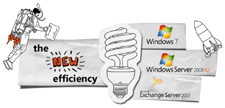
Windows Server 2008 R2 and Windows 7 - Better
Together
by
David Tan, Chief Technology Officer, CHIPS Technology Group LLC
 Lost in all the hype about the recent Windows 7 is
the excitement around the simultaneous launch of Windows Server 2008 R2.
There are probably a few reasons this launch has been so overlooked.
First, as I mentioned, it came hand-in-hand with the desktop launch.
Clearly, Microsoft's marketing team doesn't plan any "I'm a Windows
Server" commercials to go along with their current "I'm a PC" campaign, so
the masses will often not know about the server. Second is the naming
convention. This is the second time Microsoft has chosen to stick the R2
moniker at the end of a server product name (Windows Server 2003 R2
started the trend) for some unknown reason. I realize they probably don't
want to go through a rebranding campaign every 18 months, but R2 does add
much excitement to a product launch. Make no mistake however; Server 2008
R2 is a substantial new product release with a wealth of outstanding new
features, and something to certainly get excited about.
Lost in all the hype about the recent Windows 7 is
the excitement around the simultaneous launch of Windows Server 2008 R2.
There are probably a few reasons this launch has been so overlooked.
First, as I mentioned, it came hand-in-hand with the desktop launch.
Clearly, Microsoft's marketing team doesn't plan any "I'm a Windows
Server" commercials to go along with their current "I'm a PC" campaign, so
the masses will often not know about the server. Second is the naming
convention. This is the second time Microsoft has chosen to stick the R2
moniker at the end of a server product name (Windows Server 2003 R2
started the trend) for some unknown reason. I realize they probably don't
want to go through a rebranding campaign every 18 months, but R2 does add
much excitement to a product launch. Make no mistake however; Server 2008
R2 is a substantial new product release with a wealth of outstanding new
features, and something to certainly get excited about.
There is good reason why the new network operating systems was shipped the same time as the desktop. There are a ton of features that are designed to work specifically with clients running Windows 7. It's clearly Microsoft's hope that if the lure of Windows 7 on its own is not enough to force a desktop upgrade, the combined power of the two will push it over the edge. They may be on to something with this strategy. While some of the stand-alone or upgraded features are awesome (new versions of Hyper-V and Remote Desktop Services, better performance and scalability), it's when you combine Server 2008 R2 with Windows 7 that you get all the real benefits.
First among the new features to get excited about is BranchCache. As the name would suggest, BranchCache is a technology that allows machines running Windows 7 in remote (or branch) offices to cache commonly used content for much faster access times and performance. This also cuts down on the bandwidth needed at these locations, saving money for the organization. Technology like this has long been available with expensive hardware and software solutions, but Windows Server 2008 R2 includes it right in the product, making it affordable and easy to implement.
Another exciting new feature is called DirectAccess. The technical specifications of this are well beyond the scope of this article, but basically, Direct Access is a method for remote users to connect directly to network resources without the cost and complexity of a VPN connection. This gives remote users the exact same experience inside the office or out, and makes things like accessing internal links in e-mails or managing network shortcuts absolutely seamless. This is all done while maintaining the strict security requirements that you put in place for your organization.
Windows Server 2008 R2 also shines with new security and performance features. Technologies like read-only DFS replicas help you lock down your digital assets which are often the keys to the company castle, even in remote locations that you can't physically monitor closely. For companies considering a desktop virtualization initiative as a way to cut costs and improve management, the new RemoteApp & Desktop (RAD) feature improves on the end-user experience and makes performance for these configurations as good if not better than their traditional desktop counterparts. If you do use VPN connections for remote offices or users, the new Agile VPN feature significantly enhances the resiliency of these connections, allowing users to focus on work, not connectivity issues.
As you can clearly see, Microsoft has built their new Server and Desktop operating systems to really work better hand-in-hand. If you haven't looked at Windows Server 2008 R2 or Windows 7 for that matter, now is a really good time to consider the cost and performance benefits of an upgrade for your organization. If you want to know how this can benefit you, contact us to talk about a demo or a pilot of the new systems today.